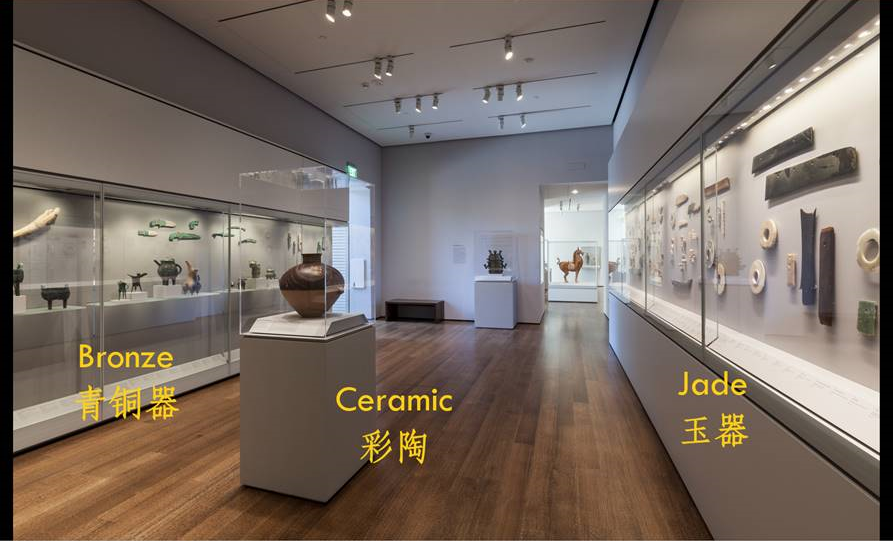1975.41.21: Fragment: Braid Motif
Textile ArtsThe tapestry-woven woolen textile fragment depicts a four-strand braid woven in red and yellow on a black ground with small white dots between the plait strands. Above and below the strand is a light blue border, and below is a fragment of the plain-woven ground the piece was set into. The right and left edges are fragmentary.
Identification and Creation
- Object Number
- 1975.41.21
- Title
- Fragment: Braid Motif
- Classification
- Textile Arts
- Work Type
- textile
- Date
- 4th-5th century
- Places
- Creation Place: Africa, Egypt
- Period
- Byzantine period, Early
- Culture
- Byzantine
- Persistent Link
- https://hvrd.art/o/288238
Physical Descriptions
- Medium
- Wool and linen, tapestry and plain weave
- Technique
- Woven, mixed technique
- Dimensions
- actual: 44.5 x 17.58 cm (17 1/2 x 6 15/16 in.)
Acquisition and Rights
- Credit Line
- Harvard Art Museums/Arthur M. Sackler Museum, Gift of The Hagop Kevorkian Foundation in memory of Hagop Kevorkian
- Accession Year
- 1975
- Object Number
- 1975.41.21
- Division
- Asian and Mediterranean Art
- Contact
- am_asianmediterranean@harvard.edu
- Permissions
-
The Harvard Art Museums encourage the use of images found on this website for personal, noncommercial use, including educational and scholarly purposes. To request a higher resolution file of this image, please submit an online request.
Descriptions
- Description
-
This wide tapestry band in polychrome wool and linen is probably a fragment from a large hanging. It possibly represented a decorated column, which were common devices for dividing up scenes and motifs and evoking architecture on large-scale wall hangings. These columns were elaborately and colorfully decorated, with braid motifs especially favored.
This fragment’s design consists of a simple double-filleted border (green and buff) on either side of a four-strand braid against a dark background. Buff dots fill the interstices in the braid. Each strand of the braid is composed of three different colors (either red, light buff, and dark buff or light yellow, dark yellow, and dark buff), the lightest of which is always in the middle—creating an effect of shading and variety. Each strand has a dark outline that blends into the braid’s background.
The linen warps run perpendicularly to the length of the braid design, further supporting the suggestion that this piece belonged to a long curtain.
A strip of plain-woven linen survives on one side of the tapestry band. - Commentary
-
Similar to small fragment in Yale University Art Gallery (1956.8.6) and Metropolitan Museum of Art 90.5.841.
For large hangings with braided columns, see Metropolitan Museum of Art 22.124.3 and 22.124.6 and Victoria and Albert Museum T.232-1917. See the braided column on the far leftof the Dionysus Hanging in the Abegg-Stiftung (3100a) and in Museum of Fine Arts, Boston 57.180.
The braid motif is also very similar to the fresco from Bawit Chapel I, north wall. This is illustrated in Jean Clédat, Le monastère et la nécropole de Baouît (MIFAO 12), Cairo: Le Caire imprimerie de l’Institut français d'archéologie orientale, 1904, Pl. XI.
Publication History
- Ioli Kalavrezou, Byzantine Women and Their World, exh. cat., Harvard University Art Museums (Cambridge, MA, 2003), p. 172/fig. 90
Exhibition History
- Byzantine Women and Their World, Harvard University Art Museums, Cambridge, 10/25/2002 - 04/28/2003
- 32Q: 3740 Egyptian, Harvard Art Museums, Cambridge, 11/20/2019 - 11/15/2021
Related Articles
Verification Level
This record has been reviewed by the curatorial staff but may be incomplete. Our records are frequently revised and enhanced. For more information please contact the Division of Asian and Mediterranean Art at am_asianmediterranean@harvard.edu
